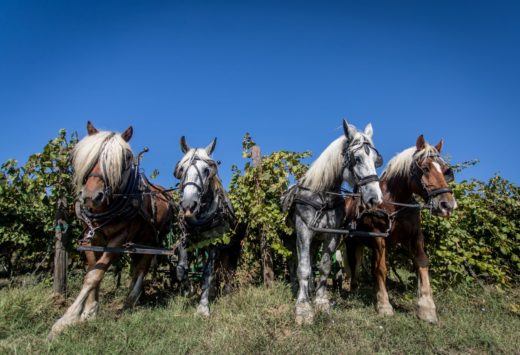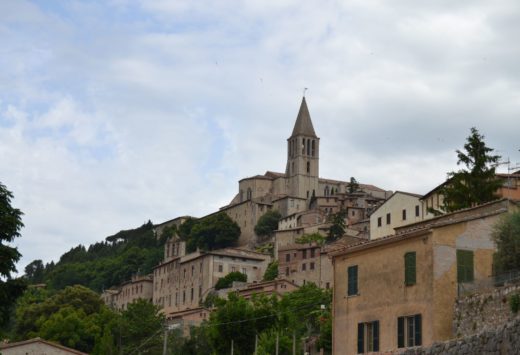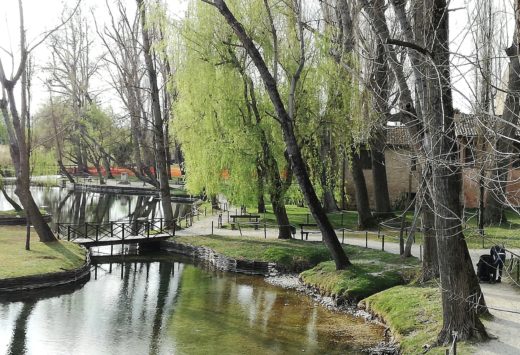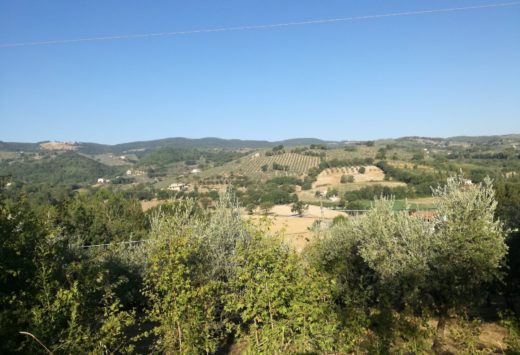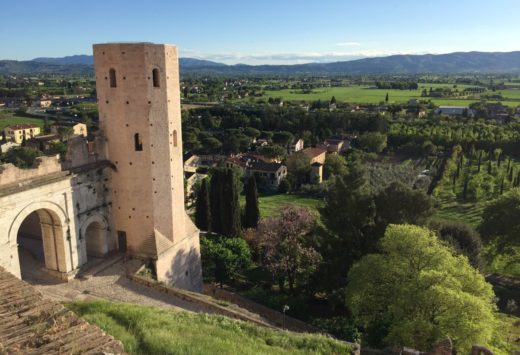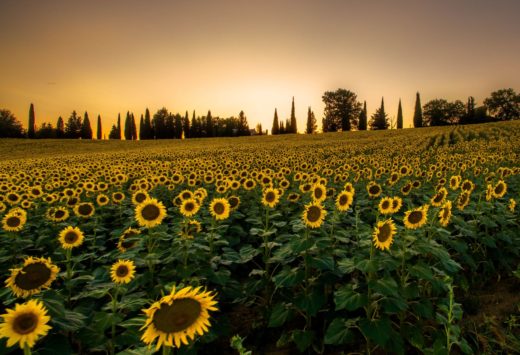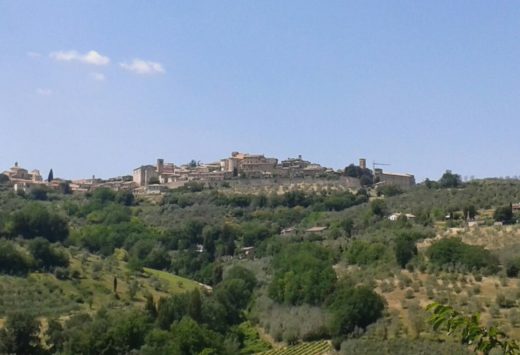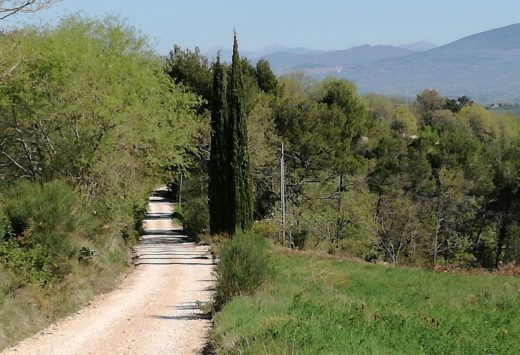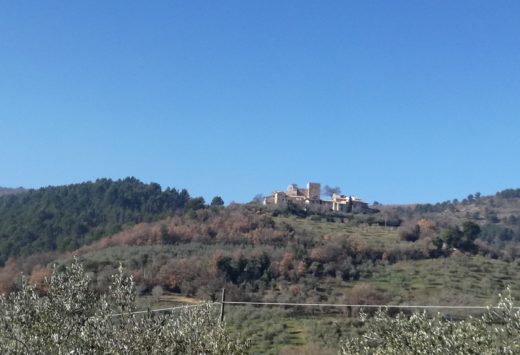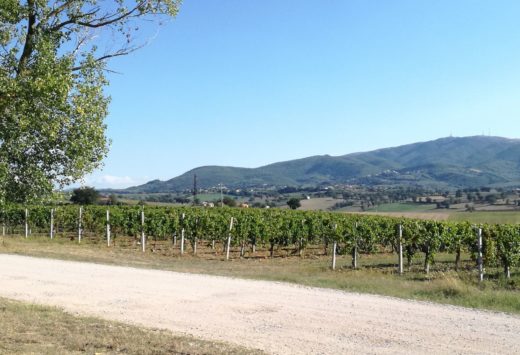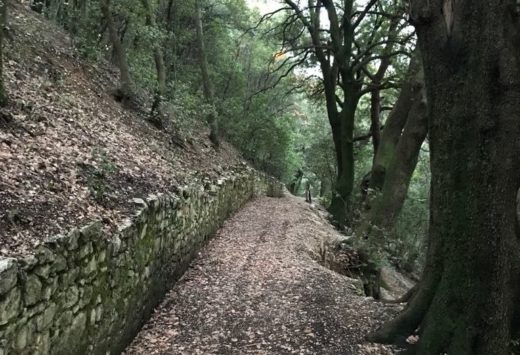Discover with us the village of Torgiano.
Nestled among vine rows and olive groves, Torgiano has always been infused with the aromas of the products of its land: oil and wine. Its history dates back thousands of years: most likely as far back as the Etruscan period. This is evidenced by some findings in the surrounding area, as well as its proximity to Bettona, the ancient Etruscan ‘Vettona’. The arrival of this population marked the beginning of the reclamation of Lake Tiberino’s marshes; the basin that from San Sepolcro extended as far as Terni. This work of reclaiming land continued with the Romans, who built canals to drain the water and protect agricultural production.
Torgiano rises where the Chiascio and the Tiber rivers converge. In Etruscan-Roman times, the latter was navigable from Città di Castello to Rome. Indeed, the Roman settlement developed as an important river port. It was destroyed, however, by the Goths of Agilulf in 595 AD. and later counted amongst the Byzantine possessions, while neighbouring Rosciano came under the Duchy of Spoleto.
Torgiano was reborn in the 13th century with the Municipality of Perugia, which decided to build the settlement of castrum Torsciani. It was built on the site of the pre-existing remains of the Roman settlement together with some houses, in the area of the current parish church of San Bartolomeo. It was Perugia itself that also built the castrum Grifonis, the current Brufa; in the same period, Fra Bevignate built the Ponte Nuovo bridge just downstream of the convergence of the Tiber and Chiascio.
For centuries, the fortified village went on to experience the same fate as the nearby city of Perugia and suffered the consequences of its internal struggles, such as those of the nobles and the guilds of the artisan bourgeoisie. On the occasion of the occupation by his militias, Muzio Attandolo Jacopo called ‘Lo Sforza’ went to Torgiano. Here, according to some historians, he met the woman who would become the mother of his son Francesco, the future Duke of Milan.
In 1426 a vicar sent from Perugia was made governor of the village. During this same period, many families from Perugia’s aristocracy settled in Torgiano, including the Ubaldi and the Baglioni: in the 17th century, the latter built their own palace, now transformed into the Museo del Vino by the wine producer Lungarotti. Subsequently, in 1478 Torgiano was devastated by the plague and sacked by the Duke of Valentino’s 10,000 soldiers. On this occasion, Cesare Borgia was accompanied by Niccolò Machiavelli who wrote a letter here on Umbrian politics. In 1540 the Salt War marked the defeat of Perugia and the transfer of Torgiano to the properties of the Papal State, under which it remained until the Unification of Italy, except during the Napoleonic period, when it was annexed to the Canton of Deruta.
During the 19th century, while the rest of the region experienced a breakdown of the large landed estates, two important, vast estates were founded in Torgiano. One was the estate of the Meniconi Bracceschi counts, the other that of the future cardinal Pietro Ugo Spinola. With the unification of Italy and later with the industrialization of the 1950s and 1960s, the social-economic scenario continued to change, turning increasingly towards modernization and increasing the area’s income. Thanks to investments in the area, Torgiano has become a premium site for the production of oil and wine (its DOC and DOCG products are renowned worldwide). It is also an attractive area from a cultural and naturalistic point of view, given the beauty of its historic centre and its almost untouched rural landscape: all characteristics of alternative, quality tourism.
Torgiano is numbered amongst the Borghi più Belli d’Italia (‘most beautiful villages in Italy’), as well as being an Oil and Wine Town and is part of the Strada dei Vini del Cantico (Cantico Wine Route), a Slow Food town and a member of the Communità Montana Monti del Trasimeno (Monti del Trasimeno Mountain Community). Its history is intertwined with that of Giorgio Lungarotti. The father of Umbrian viticulture and undisputed star of the history of Torgiano, in 1962 he opened the Lungarotti winery. Even today this is an unmissable stopping off point if you visit the village, as is the Wine Museum and the Olive and Oil Museum. Both are managed by the Lungarotti Onlus Foundation. Alongside its two primary products, Torgiano offers exquisite typical dishes prepared with wheat and flour, such as the torta al testo, the Easter cake, the schiacciata flatbread, and the legume and vegetable soup.
Numerous events see Torgiano spring to life during the year; needless to say, the majority of these owe their origin to the traditions that revolve around the produce of the land. The Fuochi di San Giorgio (Fires of San Giorgio), on April 23rd are celebrated as a good omen for the harvest. In April and May you can explore the Torgiano countryside on foot or by bike and visit wineries on their Open Day event called ‘Cantine Aperte’. At Easter, during the ‘Gustando il Borgo’ event, you can taste DOC and DOCG wines and foods.
The annual festival of San Lorenzo features traditional dishes and shows, while the previous night the ‘Calici di Stelle’ event kicks off with music and refreshment points dotted along the streets of the village. The ‘Agosto Torgianese’ festivities come to an end with ‘I Vinarelli’, an event in which artists create their works with paints diluted with wine. More art follows in November, on the occasion of ‘Vaselle d’autore per il Vino Novello’, an exhibition that hosts famous artists who work with ceramics. The new olive oil production is celebrated in the same month at the ‘Festa dell’Olio Nuovo’.


